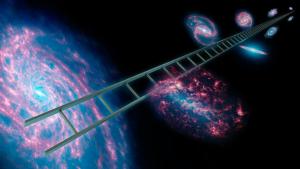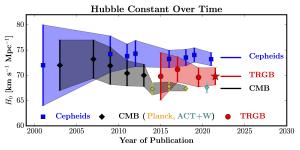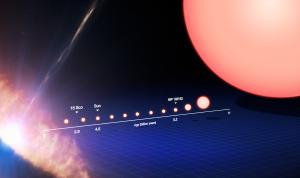Blog
Relieving Tension
6 July 2021
 NASA/JPL-Caltech/R. Hurt (IPAC)
NASA/JPL-Caltech/R. Hurt (IPAC)The standard model of cosmology is known as the LCDM model. Here, CDM stands for Cold Dark Matter, which makes up most of the matter in the universe, and L stands for Lambda, which is the symbol used in general relativity to represent dark energy or cosmic expansion. While the observational evidence we have largely supports the LCDM model, there are some issues with it. One of the most bothersome is known as cosmic tension.
It centers on our measurement of the Hubble constant, which tells us the rate at which the universe has expanded over time. There are lots of ways to measure the Hubble constant, from the brightness of distant supernovae, to the clustering of galaxies, to fluctuations in the cosmic background, to the light of microwave lasers. All of these methods have advantages and disadvantages, but if our cosmological model is right they should all agree within the limits of uncertainty.
 Wendy Freedman
Wendy FreedmanThe problem is, they don’t agree.1 Back in the early days of cosmology the uncertainty of our measurement was so large that all these results overlapped, but as our measurements got better it became clear different methods gave slightly different values for the Hubble constant. In polite company, astronomers say there is tension between these values.
This tension means that either our measurements are a bit off, or there is something wrong with our model. This has led some astronomers to propose some missing aspects to our model, such as how the mass of neutrinos might realign our Hubble values. But as new measurements of the Hubble constant keep coming in, it looks as if the tension is just getting worse. Now a new paper from Wendy Freedman argues that the tension problem isn’t that bad and that the tension will likely fade as the next generation of telescopes gives us even better data.2
As it stands, the main tension in Hubble values arises between methods that rely upon the cosmic distance ladder, such as supernova observations, and those that don’t, such as the cosmic microwave background (CMB).
With CMB fluctuations, you basically measure the scale at which small variations in temperature are most prevalent, and compare that with the clustering of galaxies we see today. This gives you a measure of how much the universe has expanded. The downside of this method is that CMB light is the most distant light we can observe. Much of it has passed through gas and dust to reach us, so it can difficult to distinguish whether fluctuations are inherent to the cosmic background or due to dust blocking some of the light.
With supernovae, you compare the observed brightness of a Type Ia supernova with its actual brightness. Since more distant objects appear fainter than close ones, you can use this comparison to measure far galactic distances. Unfortunately, to know the actual supernova brightness, which you can only do if you already know the distance. So astronomers use other methods such as Cepheid variables to measure the distance to nearby galaxies, use observations of supernovae in those galaxies to determine their brightness, and then use that to measure more distant galaxies. Thus a ladder of distance observations.
 ESO/M. Kornmesser
ESO/M. KornmesserIn this new paper, Freedman shows that Cepheid variables aren’t quite the standard we take them for. In comparison, red giant stars can be used in distance measures, since they have a consistent maximum brightness before they fade. When using red giant stars in the cosmic distance ladder, the supernovae method gives a Hubble value much more consistent with the CMB method. As Freedman sees it, as new telescopes give us more accurate observations of Cepheid variables and red giant stars the gap will further close.
The tension problem in cosmology is by no means solved. But perhaps it won’t really be a problem in the end. Either way, Freedman is absolutely right that more observations and better data is the solution.
Freedman, Wendy L., et al. “The Carnegie-Chicago Hubble program. VIII. An independent determination of the Hubble constant based on the tip of the red giant branch.” The Astrophysical Journal 882.1 (2019): 34. ↩︎
Freedman, Wendy L. “Measurements of the Hubble Constant: Tensions in Perspective.” arXiv preprint arXiv:2106.15656 (2021). ↩︎